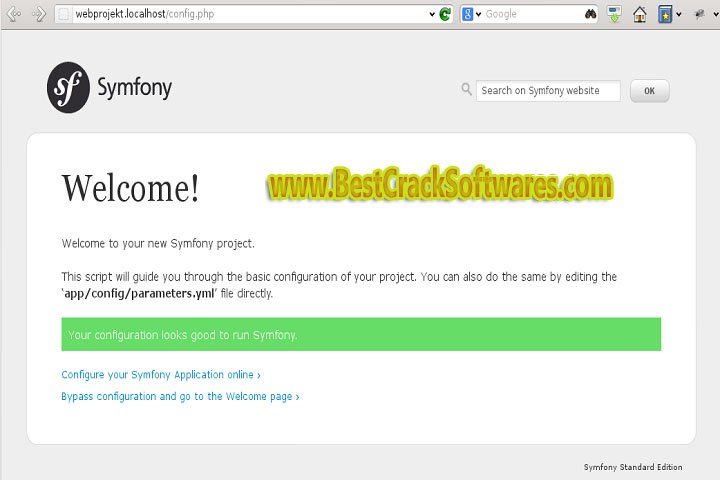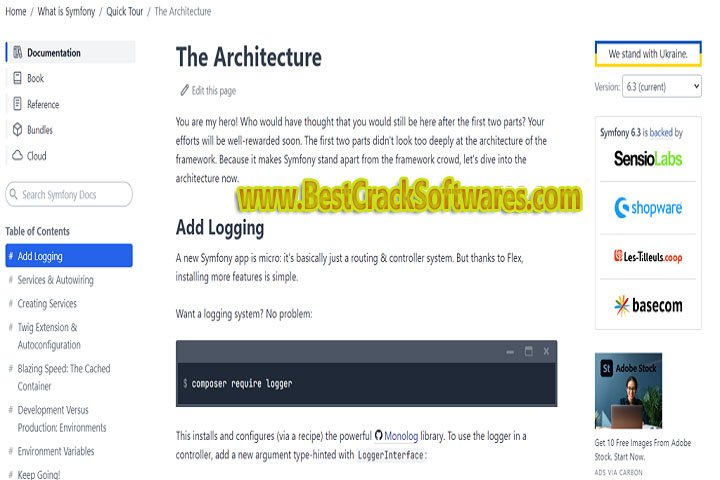Symfony 6.3.2 Pc Software
Symfony 6.3.2 Pc Software
In the ever-evolving field of web development, having a powerful and efficient PHP framework at your disposal is vital. Symfony 6.3.2, the latest generation of this powerful software, continues to be a cornerstone in the domain of web application development.

In this detailed essay, we will delve into the software overview, investigate its significant features, dive into the technical setup specifics, and explain the system requirements essential for unleashing the full power of Symfony 6.3.2.
You may also like this :: HWI 760 Pc Software
Symfony 6.3.2 Software Overview
Symfony, originally published in 2005, has progressively evolved to become one of the most popular PHP frameworks worldwide. Developed by SensioLabs, Symfony is recognized for its modularity, adaptability, and robustness. Symfony uses the Model-View-Controller (MVC) architectural paradigm, making it appropriate for a wide range of web development projects, from simple websites to large-scale apps.
Symfony 6.3.2 Key Features
1. Modularity
Symfony’s modularity is a noteworthy feature. It allows developers to use certain components independently or as part of a full-stack framework. This modular approach enhances code reusability and simplifies maintenance.
2. Flexibility
Symfony gives developers the ability to choose the components and libraries they require for their project. This flexibility helps developers design bespoke solutions for varied usage situations.
3. Community and Ecosystem
Symfony features a robust and active community, assuring continuing support, updates, and a multitude of third-party bundles and extensions available via Symfony Flex, the project’s official package manager.

4. Performance
Symfony has achieved substantial performance gains throughout the years. With each new version, it continues to optimize code execution, reducing response times and boosting overall application performance.
Symfony 6.3.2 Software Features
Symfony 6.3.2 expands upon its predecessors with a collection of intriguing improvements meant to speed development and enhance the user experience. Here are some of the key features:
### 1. Symfony Console Component
The Symfony Console Component facilitates command-line application development. It offers a basis for constructing CLI tools, making operations like database migrations and application deployments a snap.
### 2. Dependency Injection
Symfony’s Dependency Injection Containers help developers manage and inject application dependencies effortlessly. This promotes clear, maintainable code and helps with testing.
3. Doctrine Integration
Symfony effortlessly integrates with Doctrine, a popular object-relational mapping (ORM) library. This connection streamlines database interactions, boosting data modeling and database schema maintenance.
### 4. Twig Templating Engine
Twig, the default templating engine in Symfony, emphasizes separation of concerns and gives a succinct and expressive syntax for building templates. It helps build user-friendly and dynamic web sites.
### 5. Security Component
Symfony’s Security Component provides a solid framework for establishing authentication and permission in online applications. It contains tools for user administration, authentication providers, and role-based access control.
6. Routing and URL Generation
Symfony’s routing mechanism helps developers build explicit and structured URL patterns for their applications. This feature facilitates the design of SEO-friendly URLs and enhances user navigation.
You may also like this :: Rocrail Windows WIN 32 Pc Software
Symfony 6.3.2 Software Technical Setup Details
### Installation
Symfony 6.3.2 can be installed using Composer, a popular PHP package manager. Here are the procedures for setting up Symfony:

1. Ensure you have Composer installed globally on your machine.
2. Create a new Symfony project using Composer: “`bash composer create-project symfony/skeleton my_project_name “`
3. Follow the prompts to modify your project and install any required dependencies.
### Configuration
Symfony’s configuration is kept in the `config` directory. Key configuration files include `routes.yaml` for defining routes, `services.yaml` for configuring services and dependencies, and `.env` for environment-specific variables.
### Development Server
Symfony offers a built-in web server for local development. To start the development server, use the following command from your project’s root directory:
“`bash symfony serve “`
Symfony will give a local development URL (e.g., http://127.0.0.1:8000) for accessing your application.
Symfony 6.3.2 Software System Requirements
Before you continue on your Symfony adventure, it’s vital to ensure that your development environment matches the necessary system requirements:
1. PHP Version: Symfony 6.3.2 requires PHP 7.4 or higher. Ensure you have PHP installed and set correctly on your machine.
### 2. Composer
Composer is a necessity for handling Symfony dependencies. Install it globally on your PC to get started.
### 3. Web Server
For deploying Symfony applications to production, you’ll need a web server like Apache or Nginx. However, for local development, Symfony’s built-in web server suffices.

4. Database Symfony supports multiple database systems, including MySQL, PostgreSQL, SQLite, and more. Ensure you have your database system installed and configured.
### 5. Web Browser
A contemporary web browser is important for testing and debugging your Symfony applications.
You may also like this :: Driver Easy 5.8.1.41398 Pc Software
Symfony 6.3.2 Conclusion
Symfony 6.3.2 continues to be a driving force in the PHP web development environment. Its modularity, versatility, and comprehensive feature set make it a good choice for developers trying to create strong and scalable web applications. By adhering to the system requirements and following the technical setup guidelines, you may launch on your Symfony journey and harness its amazing features to build cutting-edge web applications.
Symfony helps developers bring their web development goals into reality while adhering to best practices and industry standards. Stay tuned for more upgrades and additions as Symfony’s dedicated community continues to push the frontiers of web development possibilities.
Download Link : Mega
Your File Password : BestCrackSoftwares.com
File Version 6.3.2 & Size : 12 MB
File type : Compressed / Zip & RAR (Use 7zip or WINRAR to unzip File)
Support OS : All Windows (32-64Bit)
Upload By : Somia Saleem
Virus Status : 100% Safe Scanned By Avast Antivirus



